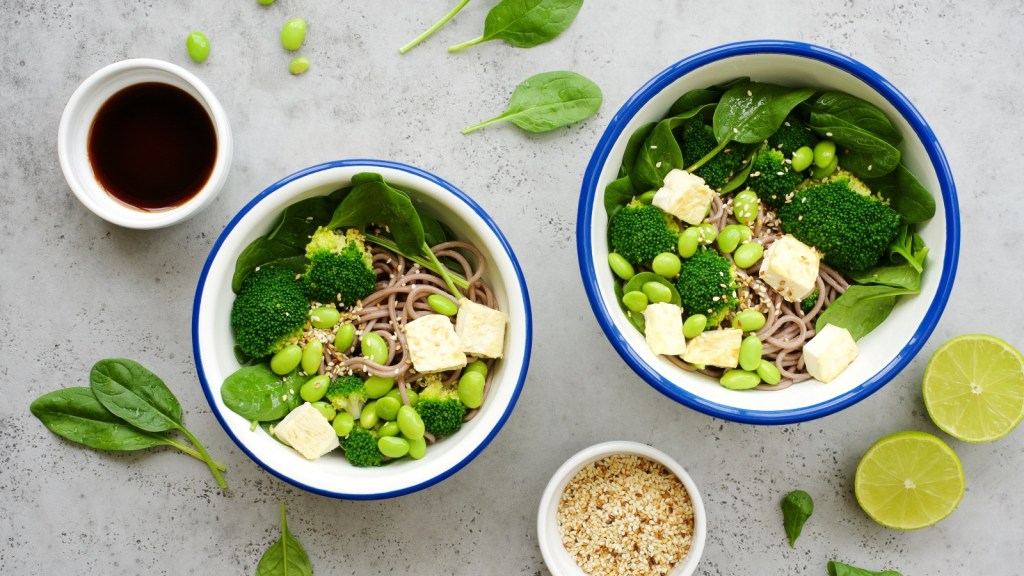Someone following a plant-based diet – or considering making the switch – may be concerned about their protein intake.
Although animal proteins are ‘complete’, experts advise that protein quality on a plant-based diet can be as good as an omnivore diet. It just takes a little planning.
Here’s the difference between animal and plant-based protein explained, how much protein a person needs per day and 15 of the best plant-based protein sources.
About plant-based proteins
People need adequate dietary protein for normal growth, development, and functioning. Amino acids in foods are building blocks for protein. We use amino acids for vital processes like the synthesis of neurotransmitters and hormones, and making muscle and other tissues.
Animal proteins contain all nine essential amino acids, and nutritionists refer to them as ‘complete’ proteins. However, plant-based proteins provide a range of amino acids, with some amino acids being present in smaller quantities. When an amino acid is low in plant food, nutritionists refer to it as ‘limiting’, meaning it limits the opportunity to synthesize (or make) a complete protein.
Therefore, people eating a plant-based diet should consume a range of different protein sources to provide the complementary amino acids to make protein. An example of combining complementary proteins in the same meal is rice with beans or flatbread with lentil dahl.
However, research indicates that it is unnecessary to eat complementary proteins at each meal; it is sufficient to consume them within the same day.
The British Nutrition Foundation advises that if vegetarians and vegans eat various vegetable proteins in combination, there is no reason why the quality of protein cannot be as good as in a diet comprising meat, milk, fish, eggs, or other foods that contain animal protein.
Furthermore, it is worth noting that some plant foods such as quinoa and soy contain all the essential amino acids and are complete proteins.
How much protein do we need?
According to the British Nutrition Foundation, most adults require 0.75 grams (g) of protein per kilogram (kg) of body weight daily (g/kg/d). It notes that protein requirements increase in pregnancy by 6g per day and lactation by 8-11g, depending on the infant’s age.
The Dietary Guidelines for Americans advise adults to consume 10-35 percent of their daily calories as protein, 46g for females and 56g for males.
It’s important to note that the amount of protein that someone requires may vary depending on their activity levels and the type of exercise they do.
For example, the International Society of Sports Nutrition (ISSN) recommends 1.4-2 g/kg/d protein for building and maintaining muscle mass. However, they also note that there is evidence that higher protein intakes of over 3 g/kg/d may have positive effects on body composition in resistance-trained individuals.
However, a 2016 study advises that although long-term consumption of 2 g/kg/d protein is safe for healthy adults, long-term intakes of higher than this may result in digestive, renal, and vascular abnormalities. Harvard Health also agrees that until experts are conclusive about safe amounts, untrained individuals should aim for no more than 2 g/kg/d.
Related articles…
Plant-based protein sources
Tofu
Containing 8.08g of protein per 100g, tofu is a source of minerals, including calcium, magnesium, and iron.
Furthermore, tofu contains isoflavones which some research suggests may be beneficial for hot flashes and improving arterial health in menopause.
People can purchase a firm or silken tofu to use in various ways, including stir-fries, burgers, and scrambled eggs.
Edamame beans

Edamame beans are whole, bright green, immature soybeans. Grocery stores typically sell them frozen for people to steam and add to stir-fries, soups, or salads. People can also make them into a tasty dip.
One cup of edamame beans contains 18.4g of protein and all the essential amino acids. Additionally, they are a good source of calcium, magnesium, and vitamin K.
Lentils
Lentils are a popular protein choice for people eating a plant-based diet, with one cup of cooked lentils providing 17.9g of protein.
Additionally, lentils are a source of fiber, B vitamins, and calcium.
People can choose from red, green, and brown lentils and use them to make dahls and curries or add to cooked or raw vegetables. Serving lentils with rice gives the meal a good amino acid profile.
Chickpeas
Chickpeas or garbanzo beans are a versatile and tasty source of plant-based protein. A 253g can of chickpeas contains 17.8g of protein. In addition, chickpeas are a low-fat, high-fiber food providing a good source of calcium and magnesium.
People can incorporate canned chickpeas into salads or use them to make a quick hummus by adding protein-rich tahini. Likewise, serving a chickpea curry or dahl with brown rice provides a wholesome meal rich in amino acids.
Oats
Oats are an all-round excellent choice for breakfast.
A 50g serving of rolled oats contains 7g of protein. Furthermore, someone can increase the protein content of breakfast oatmeal by adding chopped nuts and seeds.
Additionally, oats are a good source of fiber and beta-glucans, which research indicates may help balance blood sugar, lower cholesterol, and support the immune system.
Seitan
Seitan (pronounced SAY-tan) is made from vital wheat gluten and forms the basis of many fake meats that people can buy in grocery stores or eat in restaurants.
Manufacturers use high-protein vital wheat gluten to shape and flavor into different foods with a meaty texture. People can also purchase the flour and make seitan themselves.
Containing 76.67g of protein per 100g, seitan can make a good protein source for people on a plant-based diet. However, people should be aware of processed fake meats’ fat, sugar, and salt content. Furthermore, seitan is not suitable for people eating a gluten-free diet.
Hemp seeds
Hemp seeds are rich in protein and omega-3 fatty acids. Three tablespoons of hulled hemp seeds provide 9.48g of protein.
The outer shell of hemp is indigestible, so people can purchase shelled hemp hearts to add to salads, smoothies, and cooked meals. In addition, hemp hearts are a good source of minerals, B vitamins, and fiber.
Additionally, people can consume hemp as a protein powder or oil.
Grains
Grains such as wheat and rice provide essential amino acids on a plant-based diet. However, people should choose mainly whole grains to help balance their blood sugar and energy requirements.
Some grains to include on a plant-based diet and their protein content per 100g are as follows:
Furthermore, grains provide fiber and essential vitamins and minerals.
Nuts

Nuts are a healthy addition to a plant-based diet and a good source of protein. For example, protein per 100g of popular types of nuts is as follows:
Furthermore, nuts contain fiber, minerals such as calcium and zinc, and healthy fats. Walnuts, in particular, are a good source of omega-3 fatty acids.
In addition, a 2019 review suggested that consuming nuts reduces the incidence of and mortality from cardiovascular diseases.
Quinoa
Although quinoa is a type of edible seed, people refer to it as a whole grain.
One cup of cooked quinoa contains around 8g of protein and all the essential amino acids, classifying it as a complete protein.
Furthermore, a cup of quinoa contains 5g of fiber and essential nutrients such as magnesium, folate, and vitamin B1.
Someone can make quinoa dishes with various vegetables, herbs, and beans or add it to homemade burger patties.
Tempeh
Manufacturers make tempeh with cooked and slightly fermented soybeans. The fermentation helps to break down phytic acid, which can inhibit the absorption of minerals.
According to a 2021 review, tempeh in the United States contains around 17g of protein per 84g average portion size. Furthermore, the review notes that tempeh is a source of calcium and B vitamins and may help to improve gut health.
Tempeh has a strong, fermented taste, and it might take a few tries for someone to get used to its flavor!
Broccoli
Although vegetables aren’t the first thing people think of when planning protein into their diets, their protein content contributes to someone’s intake in smaller amounts.
Broccoli, for example, contains 2.38g of protein per 100g, is an excellent source of folate, vitamin C, and calcium. Therefore including vegetables such as broccoli in a meal with other protein sources provides additional nutrients.
Don’t forget to use the stalks too; a medium broccoli stalk contains 4.28g of protein. Therefore someone could use a stalk to make a protein-rich broccoli ‘rice’ by blitzing it in a food processor.
Mushrooms
Mushrooms have a meaty texture and are ideal for replacing meat in a plant-based diet. For example, a grilled portabella mushroom makes a good veggie burger in a bun and contains 2.11g of protein per 100g.
Furthermore, someone could use chopped mushrooms to make mince for bolognese or chili and increase the protein content by adding red lentils or beans. Served with whole grain pasta or rice and some leafy greens, this makes a healthy meal.
Peas

Per cup, green peas have an impressive 7.86g of protein. They also provide additional nutrients such as calcium, iron, and vitamin C.
Someone could try adding a cup of green peas to stock, chopped scallions, and fresh mint and blending in a food processor to make a protein-rich tasty pea and mint soup. Furthermore, thawed frozen green peas make a healthy snack for munching on rather than potato chips!
Additionally, pea protein powder which manufacturers make from yellow peas, contains an impressive 21g of protein per 27g serving. People can blend this into smoothies or add it to breakfasts or soups.
Tahini
Tahini is a paste that manufacturers make from sesame seeds. It is a typical ingredient in hummus and makes a healthy dressing for salads and cooked vegetables.
Per 100g, tahini contains 5.05g of protein, and in one tablespoon, there is 2.67g protein. Additionally, tahini is a good source of calcium, providing 63mg in a tablespoon.
Summary
Experts advise that someone eating a plant-based diet can meet their protein requirements by ensuring they consume a variety of healthy foods.
Whole foods such as beans, nuts, and grains provide a good range of amino acids to synthesize protein. Moreover, people can include complete sources of plant proteins in their diets, such as soy and quinoa.
Furthermore, vegetables contain smaller amounts of protein and provide additional health benefits due to their vitamin, mineral, and phytonutrient content. Planning meals that include all these foods can help people optimize their health.














Leave a Comment
Plant Based News Comment Policy
In short:- If you act with maturity and consideration for other users, you should have no problems. Please read our Comment policy before commenting.